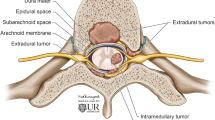Abstract
Objective
To determine the demographics, imaging findings, clinical symptoms, and prognosis of primary vertebral Ewing’s sarcoma (PVES).
Design
A retrospective review of medical records and radiological studies of patients diagnosed with PVES from 1936 through 2001 in our institution and Department of Pathology consultation files was undertaken. Metastatic and soft tissue Ewing’s sarcoma cases were excluded.
Results
From a total of 1,277 cases of Ewing’s sarcoma, 125 (9.8%) had a primary vertebral origin. There were 48 females and 76 males. Patient ages ranged from 4 to 54 (mean 19.3, standard deviation 10.7, median 16) years. Vertebral column distribution was four cervical (3.2%), 13 thoracic (10.5%), 31 lumbar (25%), and 67 sacrum (53.2%). More than one vertebral segment was involved in ten cases (8%). Satisfactory imaging studies were available in 51 patients: 49 radiographs, 27 computerized tomography (CT), and 23 magnetic resonance imaging (MRI) studies. The majority of tumors were lytic (93%). Three cases were mixed lytic and sclerotic (6%) and one sclerotic. In the nonsacral spine, the majority of lesions (12/20) involved the posterior elements with extension into the vertebral body. Five cases were centered in the vertebral body with extension into the posterior elements. Two cases were limited to the posterior elements, and one case solely involved the vertebral body. Ala was the most frequently affected site in the sacrum (18/26). Spinal canal invasion was frequent (91%). Detailed clinical information was available in 53 patients. Duration of symptoms ranged from 1 to 30 (mean 7) months. Local pain was the first symptom and seen in all cases. Neurological deficits were present in 21 (40%) cases. All patients received radiation in various dosages; 70% additionally received chemotherapy. Twenty-five patients had surgery, and two patients received bone marrow transplantation. Forty-five patients had follow-up; the five-year disease-free survival probability is 0.53. Disease-free survival probabilities are 0.60 for sacral tumors and 0.45 for nonsacral tumors.
Conclusion
PVES is an uncommon tumor, usually seen in the second decade of life (mean age 19.3 years) with a male predilection (62%). An aggressive osteolytic lesion, particularly in the sacrum, should raise suspicion for this tumor in adolescents. Prognosis was similar in sacral and nonsacral tumors.










Similar content being viewed by others
References
Ewing J. Diffuse endothelioma of bone. Proc NY Pathol Soc 1921; 21:17
Horowitz MC, Malawer MM, Woo, SY, Hicks MJ. Ewing’s sarcoma family of tumors: Ewing’s sarcoma of bone and soft tissue and peripheral primitive neuroectodermal tumors. In: Principles and practice of pediatric oncology, 3rd edn. Pizzo PA, Poplack DG, eds. Philadelphia: Lippincott-Raven 1997; 831–857
Unni KK. Ewing’s tumor. In: Dahlin’s Bone Tumors: General Aspects & Data on 11,087 Cases, 5th edn., K. Krishnan Unni, ed. Philadelphia: Lippincott-Raven 1996; 249–261
Barbieri E, Chiaulon G, Bunkeila F, et al. Radiotherapy in vertebral tumors. Indications and limits: a report on 28 cases of Ewing’s sarcoma of the spine. Chir Organi Mov 1998; 83:105–111
Villas C, San Julian M. Ewing’s tumor of the spine: report on seven cases including one with a 10-year follow-up. Eur Spine J 1996; 5:412–417
Whitehouse GH, Griffiths GJ: Roentgenologic aspects of spinal involvement by primary and metastatic Ewing’s tumor. J Can Assoc Radiol 1976 Dec; 27:290–297
Grubb MR, Currier BL, Pritchard DJ, Ebersold MJ: Primary Ewing’s sarcoma of the spine. Spine 1994; 19:309–313
Pritchard DJ, Dahlin DC, Dauphine RT, Taylor WF, Beabout JW: Ewing’s sarcoma. A clinicopathological and statistical analysis of patients surviving five years or longer. J Bone Joint Surg Am 1975; 57:10–16
Venkateswaran L, Rodriguez-Galindo C, Merchant TE. Poquette CA, Rao BN, Pappo AS. Primary Ewing’s tumor of vertebrae: clinical characteristics, prognostic factors, and outcome. Med Pediatr Oncol 2001; 37:30–35
Sharafuddin MJ, Haddad FS, Hitchon PW, Haddad SF, el-Khoury GY. Treatment options in primary Ewing’s sarcoma of the spine: report of seven cases and review of the literature. Neurosurgery 1992; 30:610–618, discussion 618–619
Pilepich MV, Vietti TJ, Nesbit ME, et al. Ewing’s sarcoma of the vertebral column. Int J Radiat Oncol Biol Phys 1981; 7:27–31
Shirley SK, Gilula LA, Siegal GP, Foulkes MA, Kissane JM, Askin FB. Roentgenographic-pathologic correlation of diffuse sclerosis in Ewing sarcoma of bone. Skeletal Radiol 1984; 12:69–78
Brodeur GM, Castleberry RP. Neuroblastoma. In: Principles and Practice of Pediatric Oncology, 3rd ed. Pizzo PA, Poplack DG, eds. Philadelphia: Lippincott-Raven 1997; 761–797
Emir S, Akyuz C, Yazici M, Buyukpamukcu M. Vertebra plana as a manifestation of Ewing’s sarcoma in a child. Med Pediatr Oncol 1999; 33:594–595
Kager L, Zoubek A, Kotz R, Amann G, et al. Vertebra plana due to a Ewing tumor. Med Pediatr Oncol 1999; 32:57–59
O’Donnell J, Brown L, Herkowitz H. Vertebra plana-like lesions in children: case report with special emphasis on the differential diagnosis and indications for biopsy. J Spinal Disord 1991; 4:480–485
Poulsen JO, Jensen JT, Thommesen P. Ewing’s sarcoma simulating vertebra plana. Acta Ortop Scand 1975; 46:211–215
Mohan V, Sabri T, Gupta RP, Das DK. Solitary ivory vertebra due to primary Ewing’s sarcoma. Pediatr Radiol 1992; 22:388–390
Bemporad JA, Sze G, Chaloupka JC, Duncan C. Pseudohemangioma of vertebra: an unusual radiographic manifestation of primary Ewing’s sarcoma. AJNR Am J Neuroradiol 1999; 20:1809–1813
Acknowledgements
The authors thank Ms. Linda Greene for manuscript preparation and Dr. J. Mandrekar, Ph.D., for statistical analysis.
Author information
Authors and Affiliations
Corresponding author
Rights and permissions
About this article
Cite this article
Ilaslan, H., Sundaram, M., Unni, K.K. et al. Primary Ewing’s sarcoma of the vertebral column. Skeletal Radiol 33, 506–513 (2004). https://doi.org/10.1007/s00256-004-0810-x
Received:
Revised:
Accepted:
Published:
Issue Date:
DOI: https://doi.org/10.1007/s00256-004-0810-x




